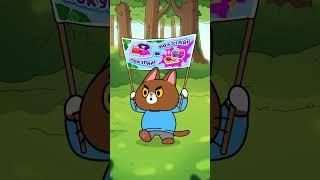
Bicycle Cross Chaining: Facts and Myths
Cross chaining explained: We have been taught that cycling in the large chainring large cog or small chainring small cog is a no no. This bicycle gearing combination is called cross chaining. We can see that the chain is at a steep angle compared to the most efficient chain line which is parallel to the frame. We've been told that the rule is you'll have less power and will wear the chain excessively. But lets have a closer look.
Wattage lose: The power loss is minimal as noted in the video from GNC in the above right.
Wear to the chain: Unless you ride constantly in either of these combinations (i.e., long periods of time), the wear with today's chains is also minimal and far less then riding with a dirty or grimy chain.
So what are the main downsides cross chaining:
1. Noise.
a. In the SMALL chainring / SMALL cog
The chain may hit the inner side of the larger chain ring.
Chain may not engage the small cog (especially on Shimano cogs).
Chain in the front chainring may make a clicking sound as the chain tries to engage the small chainring.
If there is a lot of slack in the chain, one may experience chain slap (the chain slaps against the chain stay and cause noise and damage to the paint or carbon fiber).
b. In the BIG chainring / BIG cog
The chain may rub against the inside of the inner plate of the derailleur or may not engage the cog teeth fully resulting in grinding or clicking noises.
If your chain is a little bit short and it could lockup the rear derailleur.
2. Comfort: These combinations, small/small or big/big may not feel comfortable when cycling.
3. And finally - limited ability to easily shift as the road goes up or you need to desend. In the large/large, the hill you're on suddenly gets steeper. Shifting up front puts you in the small chainring / large cog which may be far too low a gear. Therefore, you may need to shift the rear derailleur several time. The same goes for the small chainring / small cog as you come up to a descent. This inability to easily shift when road conditions change is, at least, my main reason for avoiding cross chaining.
So, is it bad to cross chain? Although you may lose minimal watts loss and slightly increase wear, the main draw back is the inablilty to EASILY shift as you approach a incline or descent. This is true whether you are cross chaining 2x11 or any other 2x or 3x combination gear combination. The optimal point to shift the front derailleur is when the chain is in the middle cogs of the cassette. Shift the chainring down for hills and up to the large chain ring for speed.
Wattage lose: The power loss is minimal as noted in the video from GNC in the above right.
Wear to the chain: Unless you ride constantly in either of these combinations (i.e., long periods of time), the wear with today's chains is also minimal and far less then riding with a dirty or grimy chain.
So what are the main downsides cross chaining:
1. Noise.
a. In the SMALL chainring / SMALL cog
The chain may hit the inner side of the larger chain ring.
Chain may not engage the small cog (especially on Shimano cogs).
Chain in the front chainring may make a clicking sound as the chain tries to engage the small chainring.
If there is a lot of slack in the chain, one may experience chain slap (the chain slaps against the chain stay and cause noise and damage to the paint or carbon fiber).
b. In the BIG chainring / BIG cog
The chain may rub against the inside of the inner plate of the derailleur or may not engage the cog teeth fully resulting in grinding or clicking noises.
If your chain is a little bit short and it could lockup the rear derailleur.
2. Comfort: These combinations, small/small or big/big may not feel comfortable when cycling.
3. And finally - limited ability to easily shift as the road goes up or you need to desend. In the large/large, the hill you're on suddenly gets steeper. Shifting up front puts you in the small chainring / large cog which may be far too low a gear. Therefore, you may need to shift the rear derailleur several time. The same goes for the small chainring / small cog as you come up to a descent. This inability to easily shift when road conditions change is, at least, my main reason for avoiding cross chaining.
So, is it bad to cross chain? Although you may lose minimal watts loss and slightly increase wear, the main draw back is the inablilty to EASILY shift as you approach a incline or descent. This is true whether you are cross chaining 2x11 or any other 2x or 3x combination gear combination. The optimal point to shift the front derailleur is when the chain is in the middle cogs of the cassette. Shift the chainring down for hills and up to the large chain ring for speed.
Тэги:
#little #big #big_ring #little_ring #shifting #cross #cross_chaining #loss_watts #watt #watts #clicking #click #noise #chainring #chain_ring #rubbing #rule #cross_chaining_bike #cross_chaining_explained #cross_chaining_2x11 #bike #bicycle #large_chainring #small_chainring #big_chainring #big_cog #small_cog #increase_wear #incline #derailleur #cog #grinding #clicking_noises #Shimano #chain_slap #easily #easily_shift #gear #shift #gear_combination #optimal #speed #cycling #cycling_tips #bike_gearsКомментарии:
Bicycle Cross Chaining: Facts and Myths
Tony Marchand
Development of External genitalia/Development of male and female external genitalia
ANATOMY BY DR VIJAYA
Večni /TV SPOT/ U bioskopima od 11. novembra
MCF MegaComFilm
2015 NBA 3-Point contest FULL FINAL ROUND
tomas manicek
Kafka becomes a kaiju and fights Kaiju No 9
TheSteamMachine
Eine Frage Der Perspektive | Julien Bam
Julien Bam
周星馳 stephen chow caught cheating
goodsoulz

![[라다의 7월 7일 NPB 스포츠분석] [前와이즈분석위원] [라다의 7월 7일 NPB 스포츠분석] [前와이즈분석위원]](https://ruvideo.cc/img/upload/Z0lCc0wzdVZRQ00.jpg)
























